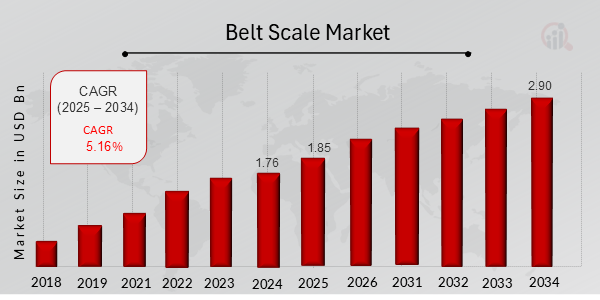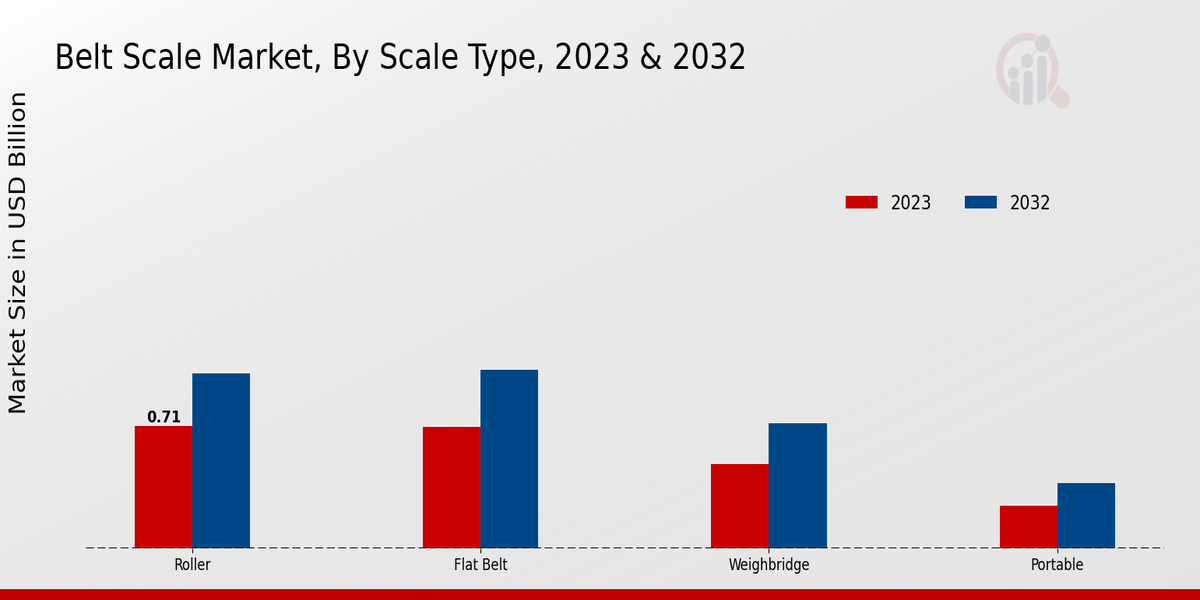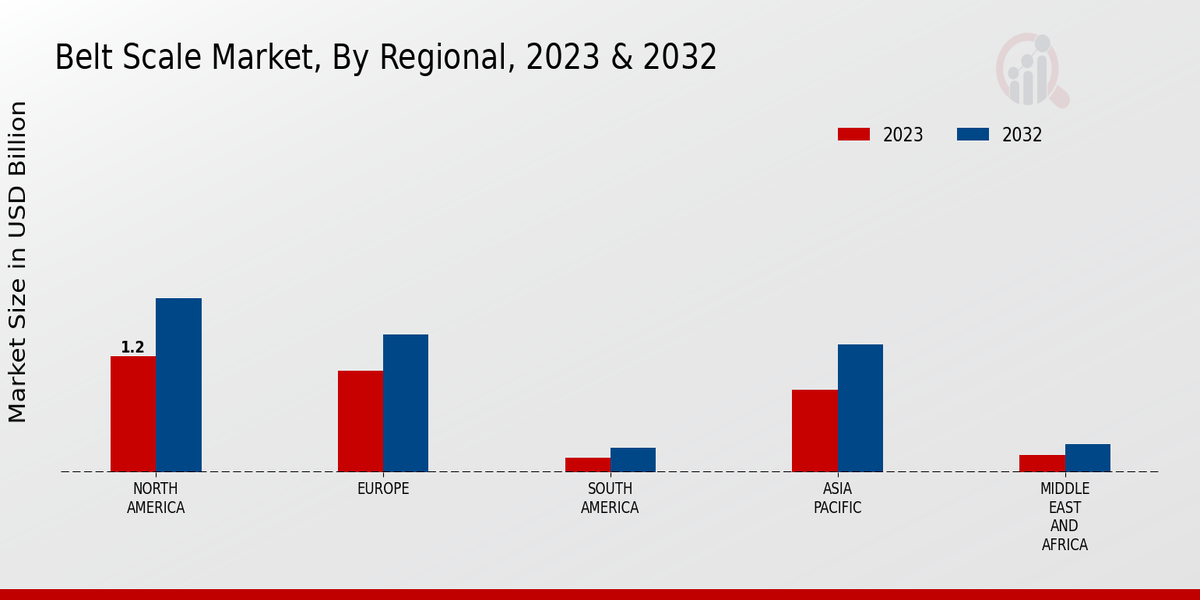Global Belt Scale Market Overview
As per MRFR analysis, the Belt Scale Market Size was estimated at 1.76 (USD Billion) in 2024. The Belt Scale Market Industry is expected to grow from 1.85 (USD Billion) in 2025 to 2.90 (USD Billion) till 2034, at a CAGR (growth rate) is expected to be around 5.16% during the forecast period (2025 - 2034)
Key Belt Scale Market Trends Highlighted
The future of the Belt Scale Market is projected to be driven by factors such as growing demand for advanced automation solutions, increasing adoption of belt scales in various industries, and government regulations mandating the use of accurate weighing systems. Recent trends in the market include the rise of smart belt scales with integrated sensors and connectivity features, which provide real-time data and improve operational efficiency. Furthermore, the adoption of Industry 4.0 technologies, such as the Industrial Internet of Things (IIoT), is creating opportunities for the integration of belt scales with other automation systems, leading to improved process control and optimization.

Source: Primary Research, Secondary Research, MRFR Database and Analyst Review
Belt Scale Market Drivers
Increasing Demand for Automated Weighing Systems in Industrial Applications
The growing adoption of automation in various industries, such as manufacturing, mining, and food processing, has led to a surge in demand for belt scales. These scales provide accurate and reliable weighing measurements in real-time, enabling improved process control, reduced waste, and increased productivity. Additionally, the ability of belt scales to integrate seamlessly with other automated systems, such as conveyor belts and control software, further enhances their appeal in industrial settings.Their ability to measure the weight of bulk materials continuously, without interrupting the flow of material, makes them a valuable asset in various production and processing operations.
Expansion of Logistics and Transportation Industry
The growth of e-commerce and the increasing demand for goods transportation have contributed to the expansion of the logistics and transportation industry. Belt scales play a crucial role in this sector, as they are used to weigh and monitor the movement of bulk materials, such as coal, grains, and minerals. The ability of belt scales to provide accurate weight measurements during loading and unloading operations ensures efficient inventory management, reduces the risk of overloads, and facilitates smooth logistics operations. Moreover, the integration of belt scales with GPS tracking systems and fleet management software enables real-time monitoring of material movement and enhances supply chain visibility.
Growing Emphasis on Energy Efficiency and Environmental Regulations
The increasing focus on energy efficiency and environmental regulations has driven the demand for belt scales in the energy and environmental sectors. Belt scales are used to monitor the consumption of coal and other fuels in power plants, enabling precise fuel management and optimization. Additionally, they are employed in waste management facilities to measure the weight of waste materials, facilitating proper waste disposal and recycling initiatives. The accurate weighing capabilities of belt scales help organizations comply with environmental regulations and contribute to sustainability efforts by reducing carbon emissions and promoting resource conservation.
Belt Scale Market Segment Insights
Belt Scale Market Scale Type Insights
The Belt Scale Market is segmented by Scale Type into Roller, Flat Belt, Weighbridge, and Portable. Among these, the Roller segment held the largest market share in 2023, accounting for around 45% of the Belt Scale Market revenue. The Roller segment is expected to maintain its dominance throughout the forecast period, growing at a CAGR of 4.5% from 2024 to 2032. The Weighbridge segment is expected to witness the fastest growth during the forecast period, with a CAGR of 5.5%. The Flat Belt segment is widely used in various industries, including mining, food processing, and logistics, due to its high accuracy and reliability.
The Weighbridge segment is primarily used for heavy-duty applications, such as weighing trucks and railcars. The Portable segment is gaining popularity due to its versatility and ease of use in various applications. The growth of the Roller segment can be attributed to its cost-effectiveness, durability, and ability to handle high volumes of material. The Weighbridge segment is expected to benefit from the increasing demand for accurate and reliable weighing solutions in the transportation and logistics industries. The Portable segment is expected to grow due to its increasing use in construction, agriculture, and other industries where portability is essential. Overall, the Belt Scale Market is expected to witness steady growth in the coming years, driven by the increasing demand for accurate and reliable weighing solutions across various industries.

Source: Primary Research, Secondary Research, MRFR Database and Analyst Review
Belt Scale Market Application Insights
The application segment plays a crucial role in understanding the dynamics of the Belt Scale Market. Mining, construction, agriculture, and manufacturing industries are the prominent users of belt scales. In 2023, the mining industry held a significant market share, driven by the increasing demand for raw materials and minerals. The construction industry is projected to witness steady growth in the coming years, owing to the rising infrastructure development activities globally. Agriculture is another significant application segment, with belt scales used for weighing and monitoring grain, feed, and other agricultural products. The manufacturing industry also utilizes belt scales for various applications, including process control, inventory management, and quality assurance. These industries are anticipated to continue driving the growth of the Belt Scale Market in the years to come.
Belt Scale Market Load Capacity Insights
The Belt Scale Market is segmented based on load capacity into low (0-10,000 kg), medium (10,000-100,000 kg), and high (over 100,000 kg). Among these, the medium load capacity segment held the largest market share in 2023, accounting for around 45% of the Belt Scale Market revenue. This is due to the widespread adoption of medium-capacity belt scales in various industries, including mining, food processing, and manufacturing. The high load capacity segment is expected to witness significant growth over the forecast period, owing to the increasing demand for high-capacity belt scales in heavy industries such as mining and construction. The low load capacity segment is also expected to grow steadily, driven by the growing adoption of belt scales in small-scale industries and warehouses
Belt Scale Market Accuracy Class Insights
The Accuracy Class segment plays a crucial role in the Belt Scale Market, influencing market segmentation and industry growth. Different accuracy classes, defined by standards such as OIML R51, OIML R60, NIST Handbook 44, and ASME B105.1, specify the permissible errors for belt scales. OIML R51, for instance, sets accuracy limits of 0.25% for Class 0.5 and 0.5% for Class 1, while OIML R60 defines accuracy classes ranging from 0.5 to 4. The choice of accuracy class depends on the specific application and industry requirements, with higher accuracy classes commanding a premium in the market.Market data indicates that the demand for belt scales with accuracy classes of 0.25 and 0.5 is expected to remain significant, driven by industries such as mining, food processing, and logistics, where precise measurement is crucial.
Belt Scale Market Belt Material Insights
The Belt Material segment is a crucial aspect of the Belt Scale Market, shaping its overall dynamics and growth trajectory. Rubber, Polyurethane, PVC, and Stainless Steel are the primary materials used in belt scales, each offering unique advantages and applications. Rubber belts are widely utilized due to their flexibility, durability, and resistance to wear and tear. They are well-suited for handling abrasive materials and are commonly found in mining, construction, and manufacturing industries. Polyurethane belts, on the other hand, excel in high-temperature applications and are often employed in food processing and packaging industries.
Their non-toxic and FDA-compliant nature makes them ideal for conveying edible products. PVC belts are cost-effective and lightweight, making them a popular choice for light-duty applications. They are commonly used in agricultural and postal industries. Stainless steel belts are highly durable and corrosion-resistant, making them suitable for harsh environments and applications involving chemicals or liquids. This growth is driven by increasing demand for belt scales in various industries, including mining, food processing, and manufacturing.
The segmentation of the market based on belt material provides valuable insights into the specific requirements and preferences of different industries, enabling manufacturers to tailor their offerings accordingly.
Belt Scale Market Regional Insights
The regional landscape of the Belt Scale Market showcases a diverse landscape with varying growth dynamics across different regions. North America, Europe, APAC, South America, and MEA constitute the key regional segments. Among these, North America and Europe have traditionally been the dominant markets for belt scales, owing to the presence of established industries and stringent regulatory frameworks. However, APAC is anticipated to exhibit the highest growth rate during the forecast period, driven by rapid industrialization and infrastructure development in countries such as China, India, and Southeast Asian nations.
South America and MEA present significant growth opportunities, particularly in the mining, agriculture, and construction sectors. The Belt Scale Market revenue in APAC is projected to reach approximately USD 850 million by 2025, demonstrating the region's increasing significance in the global market.

Source: Primary Research, Secondary Research, MRFR Database and Analyst Review
Belt Scale Market Key Players And Competitive Insights:
Major players in the Belt Scale Market industry are constantly striving to develop innovative products and enhance their market share. Leading Belt Scale Market players are focusing on strategic partnerships, acquisitions, and collaborations to expand their global reach and strengthen their competitive position. The Belt Scale Market industry is characterized by intense competition among established players and the emergence of new entrants. Key players are investing heavily in research and development to introduce advanced technologies and features into their products.Mettler Toledo is a prominent player in the Belt Scale Market, renowned for its high-quality weighing and measurement solutions. Mettler Toledo offers a comprehensive portfolio of belt scales designed to meet diverse industry requirements. The company's products are known for their accuracy, reliability, and durability. Mettler Toledo has established a strong global presence with manufacturing facilities and sales and service networks spread across multiple countries. Their commitment to innovation and customer satisfaction has positioned Mettler Toledo as a trusted partner for businesses worldwide.Meanwhile, Avery Weigh-Tronix, another leading Belt Scale Market player, has gained recognition for its innovative weighing systems and solutions. The company's belt scales are engineered to provide precise and reliable weight measurement in various industrial applications. Avery Weigh-Tronix focuses on delivering tailored solutions to meet specific customer needs. With a wide distribution network and a dedicated team of engineers and technicians, Avery Weigh-Tronix ensures the timely delivery and efficient maintenance of its products. The company's commitment to quality and innovation has earned it a loyal customer base, contributing to its position as a prominent competitor in the Belt Scale Market.
Key Companies in the Belt Scale Market Include
- Rice Lake Weighing Systems
- Coperion
- Endress+Hausser
- Buhler Group
- Yokogawa Electric Corporation
- Avery WeighTronix
- Thermo Fisher Scientific
- Honeywell International
- AZBIL Corporation
- Mettler Toledo International
- Kistler Group
- Cardinal Scale Manufacturing Company
- Schenck Process Group
- Emerson Electric
Belt Scale Market Industry Developments
The Belt Scale Market is poised to experience steady growth over the forecast period, driven by increasing demand from various industries such as mining, food processing, and manufacturing. In 2023, the market is valued at approximately USD 1.59 billion and is projected to reach USD 2.90 billion by 2034, exhibiting a CAGR of 5.16%.Recent advancements in technology have led to the development of belt scales with enhanced accuracy, reliability, and efficiency. These advancements include the use of digital signal processing, improved load cell designs, and advanced software algorithms. As a result, belt scales are becoming increasingly popular for a wide range of applications, including process control, inventory management, and quality control.The growing adoption of automation and digitalization in industries such as mining and manufacturing is also driving the demand for belt scales. These scales provide real-time data on material flow, which can be integrated into automated control systems to optimize production processes and reduce operating costs.Key players in the Belt Scale Market include METTLER TOLEDO, Avery Weigh-Tronix, Schenck Process, and Fairbanks Scales. These companies are investing heavily in research and development to introduce innovative products and expand their market share.
Belt Scale Market Segmentation Insights
- Belt Scale Market Scale Type Outlook
- Roller
- Flat Belt
- Weighbridge
- Portable
- Belt Scale Market Application Outlook
- Mining
- Construction
- Agriculture
- Manufacturing
- Belt Scale Market Load Capacity Outlook
- Low (0-10,000 kg)
- Medium (10,000-100,000 kg)
- High (Over 100,000 kg)
- Belt Scale Market Accuracy Class Outlook
- OIML R51
- OIML R60
- NIST Handbook 44
- ASME B105.1
- Belt Scale Market Belt Material Outlook
- Rubber
- Polyurethane
- PVC
- Stainless Steel
| Report Attribute/Metric |
Details |
|
Market Size 2024
|
1.76 (USD Billion)
|
|
Market Size 2025
|
1.85 (USD Billion)
|
|
Market Size 2034
|
2.90 (USD Billion)
|
|
Compound Annual Growth Rate (CAGR)
|
5.16% (2025 - 2034)
|
|
Report Coverage
|
Revenue Forecast, Competitive Landscape, Growth Factors, and Trends
|
|
Base Year
|
2024
|
|
Market Forecast Period
|
2025 - 2034
|
|
Historical Data
|
2019 - 2023
|
| Market Forecast Units |
USD Billion |
| Key Companies Profiled |
Rice Lake Weighing Systems, Coperion, Endress+Hausser, Buhler Group, Yokogawa Electric Corporation, Avery WeighTronix, Thermo Fisher Scientific, Honeywell International, AZBIL Corporation, Mettler Toledo International, Kistler Group, Cardinal Scale Manufacturing Company, Schenck Process Group, Emerson Electric |
| Segments Covered |
Scale Type, Application, Load Capacity, Accuracy Class, Belt Material, Regional |
| Key Market Opportunities |
Rising demand for continuous material monitoring proliferation of smart factories increasing automation in manufacturing growing demand from developing economies expanding food and beverage industry |
| Key Market Dynamics |
Increasing industrial automation Growing demand from mining sector Government regulations Technological advancements Rising awareness about energy efficiency |
| Countries Covered |
North America, Europe, APAC, South America, MEA |
Frequently Asked Questions (FAQ) :
The Belt Scale Market is expected to be worth 1.76 billion USD in 2024.
The Belt Scale Market is expected to grow at a CAGR of 5.16% from 2025 to 2034.
The Asia-Pacific region is expected to hold the largest market share in the Belt Scale Market in 2032.
Belt scales are primarily used in various industries for weighing bulk materials on conveyor belts.
Key competitors in the Belt Scale Market include Mettler Toledo, Avery Weigh-Tronix, and Schenck Process.
Major growth drivers of the Belt Scale Market include increasing demand for accurate and efficient weighing solutions in various industries.
Challenges faced by the Belt Scale Market include intense competition and technological advancements.
Key trends in the Belt Scale Market include the adoption of digital technologies and the growing demand for wireless and portable belt scales.
Potential opportunities in the Belt Scale Market include the expansion into emerging markets and the development of new applications.
Key developments in the Belt Scale Market include the launch of new products and the acquisition of smaller companies by larger players.

















